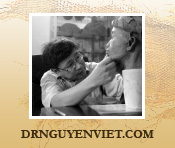|
DrNguyenViet.com >
News
>
Discoveries
The Bronze Figures of Negritos found in archaeological site of Dong Son (Thanh Hoa, Vietnam) and in Sa Thay (Kon Tum, Vietnam) [6/17/2012]
Mysterious messengers
Photos and story by Dr. Nguyen Viet
Two strange bronze statues were discovered in Dong Son village, in Vietnam’s Thanh Hoa province. For decades, these images fascinated and perplexed archaeologist Dr. Nguyen Viet. And then, in late 2009, he discovered a third statue.
Some three millennia ago, an advanced civilization arose around current-day Dong Son village, in Vietnam’s Thanh Hoa province. Famous for its elaborately carved bronze drums, this civilization became known as the “Dong Son civilization”, after the village where many artefacts were uncovered.
While most relics unearthed in Dong Son village were made by the Dong Son civilization, a strange statue was also unearthed there. Made in a wax lost mould, this human figure was unlike any art work made by the Dong Son civilization. Researchers wondered where this strange statue had come from.
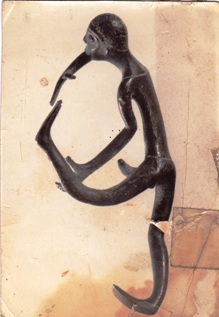
The first broze figure of Negritos found 1970 in the archaeological site of Dong Son (Thanh Hoa, Vietnam)
The 12cm-tall statue depicts a curly-haired male with protruding eyes and bulging lips. On each cheek are two lines, similar to the patterns favoured by some native groups in America. The statue’s naked body is standing in a strange position with the right foot extending straight down and the other foot supported by the left hand in an upright position. The right hand seems to work with the left hand to cover the foot. The statue’s penis is oversized. Technical marks are visible on the statue, such as a spiral pour-hole at the groin. The way that the nails are polished, the lines on the neck and waist, and the dotted curly hair mark this statue as distinct from other ancient art pieces discovered in Viet Nam and the rest of the world.
In 1987, ten years after a photo of this strange statue appeared in Archaeological Magazine, an old man from Thanh Hoa province brought a similar statue to the Institute of Archaeology in Ha Noi. He recounted how the statue had been found in his garden in Dong Son village.
This second bronze statue depicted a female. It was in very good, intact condition. The face showed deep, African-looking features with thick lips and protruding eyes. The cheeks bore two lines, like the male statue. This female statue bore oversized breasts. As the two statues are identical in artistic style and production techniques, it is clear that they are a set. The female looks up to the sky. One hand covers her face, while the other hand covers her groin. Interestingly, the female statue’s private parts fit into the hands and foot of the male statue.
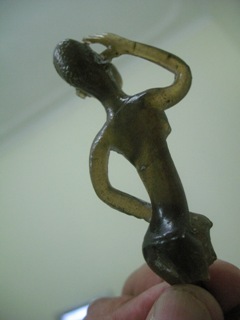 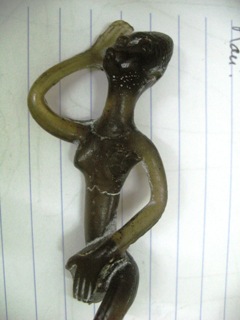
The second figire of a negrito girl found 1987 also in the archaeological site of Dong Son (Thanh Hoa, Vietnam). Here is plastic doublicate.
Thirty years ago, when I travelled to Germany for my post-graduate studies, I brought photos of these two statues. I took the images to international conferences and visited hundreds of museums all over the world in search of answers. The solution came to me in a way that I could not believe, the answer opening a path that points to one of the most mysterious interactions of prehistoric times. It turned out to be one of the most important discoveries of my 40 years as an archaeologist.
In the fall of 2009, when I was making a trans-Viet Nam field trip, I stopped in Chau O town in Quang Ngai province to view the antique collection of Mr. Lam Du Xenh. After working with his collection for one week, I was on my way to my car, when Mr. Xenh called me back : “Professor, wait! You should come back and see this,” he said. I returned and he showed me a small bronze statue. I could not believe my eyes. The statue shows a black man with curly hair, thick lips, prominent eyes and decorative lines on his cheeks. A wax moulding technique was used to make this image. The statue shows a naked man squatting and is about 11 or 12cm high. Locals had broken off both of the hands and the penis to test whether the statue was made of gold. It is easy to see the resemblance between this statue and the two others from Dong Son village. This one has two spiral pour-holes at the feet. The face is identical to those of the others. I could not contain my joy at this discovery.
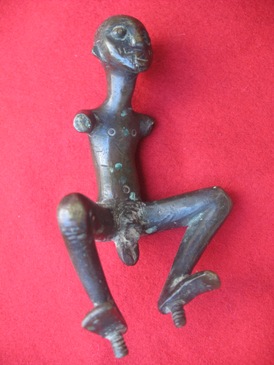 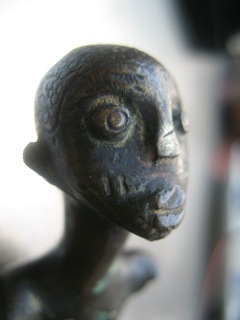 
The third figure of a negrito man found in the begining of 1980 years in Sa Thay (Kon Tum, Vietnam)
Mr. Lam Du Xenh maintained a small altar at which to pray for luck and safety before embarking on any journey. He had placed this statue in a small box in front of his altar. Every time he prepared for a long trip, he would light incense and pray before it, rubbing its head. When he returned, he would offer incense and place the statue in its former position.
During the week that we had worked together, I had shown Mr. Xenh my photos of the Dong Son statues. He hadn’t put two and two together. But as I was preparing to leave, he had offered incense to his lucky statue, as was his habit before he or his friends took a journey. Suddenly, he had seen the link. And so, he had shown me his precious statue. The joyful moment that I saw this statue was the pinnacle of my entire professional life.
Mr. Xenh told me about his introduction to the statue. In the early 1980s, while Mr. Xenh was in his twenties, he had joined many other youth volunteers in Binh Son district of Quang Ngai province. They were working in the battlefields along the Southwest border. Mr. Xenh’s division was dispatched to the Sa Thay region of Kon Tum province next to the border with Cambodia. One of his friends was given this statue by a local who had found it while working in the fields. Mr. Xenh’s friend then died of illness in Sa Thay. The statue was inherited by another member of his unit. Years later, upon learning that Mr. Xenh collected antiques, this man had given the image to him as a memento of their war years. Mr. Xenh viewed the statue as a lucky talisman.
I set out to learn the origins of these mysterious messengers that were found in Dong Son. In Southeast Asia today there are still some ethnic groups with dark brown skin and curly hair, like the Semang people in Malaysia. Could these people have once formed strong kingdoms on mainland Southeast Asia and created such lively statues?
This spring, in the month of March 2012, some colleagues and I will meet in Sa Thay and its vicinity in the hopes of discovering more traces of the people who left the mysterious statues unearthed in Dong Son.
Photos and story by Dr. Nguyen Viet
Two strange bronze statues were discovered in Dong Son village, in Vietnam’s Thanh Hoa province. For decades, these images fascinated and perplexed archaeologist Dr. Nguyen Viet. And then, in late 2009, he discovered a third statue.
Some three millennia ago, an advanced civilization arose around current-day Dong Son village, in Vietnam’s Thanh Hoa province. Famous for its elaborately carved bronze drums, this civilization became known as the “Dong Son civilization”, after the village where many artefacts were uncovered.
While most relics unearthed in Dong Son village were made by the Dong Son civilization, a strange statue was also unearthed there. Made in a wax lost mould, this human figure was unlike any art work made by the Dong Son civilization. Researchers wondered where this strange statue had come from.

The 12cm-tall statue depicts a curly-haired male with protruding eyes and bulging lips. On each cheek are two lines, similar to the patterns favoured by some native groups in America. The statue’s naked body is standing in a strange position with the right foot extending straight down and the other foot supported by the left hand in an upright position. The right hand seems to work with the left hand to cover the foot. The statue’s penis is oversized. Technical marks are visible on the statue, such as a spiral pour-hole at the groin. The way that the nails are polished, the lines on the neck and waist, and the dotted curly hair mark this statue as distinct from other ancient art pieces discovered in Viet Nam and the rest of the world.
In 1987, ten years after a photo of this strange statue appeared in Archaeological Magazine, an old man from Thanh Hoa province brought a similar statue to the Institute of Archaeology in Ha Noi. He recounted how the statue had been found in his garden in Dong Son village.
This second bronze statue depicted a female. It was in very good, intact condition. The face showed deep, African-looking features with thick lips and protruding eyes. The cheeks bore two lines, like the male statue. This female statue bore oversized breasts. As the two statues are identical in artistic style and production techniques, it is clear that they are a set. The female looks up to the sky. One hand covers her face, while the other hand covers her groin. Interestingly, the female statue’s private parts fit into the hands and foot of the male statue.
 
Thirty years ago, when I travelled to Germany for my post-graduate studies, I brought photos of these two statues. I took the images to international conferences and visited hundreds of museums all over the world in search of answers. The solution came to me in a way that I could not believe, the answer opening a path that points to one of the most mysterious interactions of prehistoric times. It turned out to be one of the most important discoveries of my 40 years as an archaeologist.
In the fall of 2009, when I was making a trans-Viet Nam field trip, I stopped in Chau O town in Quang Ngai province to view the antique collection of Mr. Lam Du Xenh. After working with his collection for one week, I was on my way to my car, when Mr. Xenh called me back.
“Professor, wait! You should come back and see this,” he said. I returned and he showed me a small bronze statue. I could not believe my eyes. The statue shows a black man with curly hair, thick lips, prominent eyes and decorative lines on his cheeks. A wax moulding technique was used to make this image. The statue shows a naked man squatting and is about 11 or 12cm high. Locals had broken off both of the hands and the penis to test whether the statue was made of gold. It is easy to see the resemblance between this statue and the two others from Dong Son village. This one has two spiral pour-holes at the feet. The face is identical to those of the others. I could not contain my joy at this discovery.
  
Mr. Lam Du Xenh maintained a small altar at which to pray for luck and safety before embarking on any journey. He had placed this statue in a small box in front of his altar. Every time he prepared for a long trip, he would light incense and pray before it, rubbing its head. When he returned, he would offer incense and place the statue in its former position.
During the week that we had worked together, I had shown Mr. Xenh my photos of the Dong Son statues. He hadn’t put two and two together. But as I was preparing to leave, he had offered incense to his lucky statue, as was his habit before he or his friends took a journey. Suddenly, he had seen the link. And so, he had shown me his precious statue. The joyful moment that I saw this statue was the pinnacle of my entire professional life.
Mr. Xenh told me about his introduction to the statue. In the early 1980s, while Mr. Xenh was in his twenties, he had joined many other youth volunteers in Binh Son district of Quang Ngai province. They were working in the battlefields along the Southwest border. Mr. Xenh’s division was dispatched to the Sa Thay region of Kon Tum province next to the border with Cambodia. One of his friends was given this statue by a local who had found it while working in the fields. Mr. Xenh’s friend then died of illness in Sa Thay. The statue was inherited by another member of his unit. Years later, upon learning that Mr. Xenh collected antiques, this man had given the image to him as a memento of their war years. Mr. Xenh viewed the statue as a lucky talisman.
I set out to learn the origins of these mysterious messengers that were found in Dong Son. In Southeast Asia today there are still some ethnic groups with dark brown skin and curly hair, like the Semang people in Malaysia. Could these people have once formed strong kingdoms on mainland Southeast Asia and created such lively statues?
This spring, in the month of March, some colleagues and I will meet in Sa Thay and its vicinity in the hopes of discovering more traces of the people who left the mysterious statues unearthed in Dong Son.
QUOTES
“While most relics unearthed in Dong Son village were made by the Dong Son civilization, a strange statue of a man—made in a different style—was also unearthed there.”
“The joyful moment that I saw this statue was the pinnacle of my entire professional life.”
“Mr. Xenh was given the bronze statue as a memento of his war years. He viewed it as a lucky talisman.”
Những cuá»™c giao lÆ°u kỳ bí từ 2000 năm trÆ°á»›c
Nguyễn Việt
Năm 1977, lần đầu tiên xuất hiện trên tạp chí “Khảo cổ há»c” của Viêt Nam má»™t bức ảnh tượng má»™t ngÆ°á»i da Ä‘en được các nhà nghiên cứu khai quáºt lại địa Ä‘iểm khảo cổ há»c Äông SÆ¡n nổi tiếng. Äó là má»™t bức tượng đồng màu xanh Ä‘en cao khoảng 12cm, tạo hình theo lối khuôn sáp (wax lost casting). Nghệ nhân tạo tượng thể hiện má»™t thanh niên tóc xoăn ngắn, mắt lồi, miệng nhô, trên má»—i bên má có hai vạch ngắn song song nhÆ° cách ngÆ°á»i da Ä‘á» Nam Mỹ trang trí trên mặt. Bức tượng ở trần thể hiện dáng đứng rất lạ : chân phải đứng thẳng trong khi trái vắt lên cao được nâng đỡ bởi cánh tay trái. Trong khi Ä‘ó, cánh tay phải vòng cong nhÆ° phối hợp cùng vá»›i chân trái ôm che má»™t váºt gì Ä‘ó. Äặc biệt dÆ°Æ¡ng váºt (penis) phóng đại rất lá»›n. Tại phần cổ và thắt lÆ°ng hiện hai Ä‘Æ°á»ng ngấn lõm nhÆ° kiểu thể hiện ngấn áo hay quần, nhÆ°ng thá»±c tế cách để lá»™ dÆ°Æ¡ng váºt và hoa vú cho thấy Ä‘ây là má»™t tượng khá»a thân (hình 1 và 2). Những yếu tố kỹ thuáºt rất đặc trÆ°ng để lại trên pho tượng nhÆ° vết Ä‘áºu rót xoắn Ä‘inh ốc ở háng, cách vuốt má»ng bàn chân, bàn tay và khía tinh hình móng chân, cách chấm tròn tạo hoa vú và mắt, ngấn ở cổ và thắt lÆ°ng, cách chấm tạo kiểu tóc xoăn ngắn (negrito "peppercorn hair")...khiến cho pho tượng khác hẳn má»i ná»n nghệ thuáºt cổ Ä‘ã phát hiện ở Việt Nam cÅ©ng nhÆ° trên thế giá»›i.

Hình 1 : Tượng đồng da Ä‘en do GS Diệp Äình Hoa phát hiện ở địa Ä‘iểm Äông SÆ¡n (Thanh Hóa), công bố trên TC "Khảo cổ há»c" năm 1977
Năm 1987, mÆ°á»i năm sau khi bức ảnh pho tượng nam được công bố, má»™t ông già nông dân từ làng Äông SÆ¡n (Thanh Hóa) mang đến Viện Khảo cổ há»c tại Hà Ná»™i má»™t pho tượng nữ bằng đồng màu xanh nâu có kích thÆ°á»›c và phong cách nghệ thuáºt hoàn toàn giống vá»›i pho tượng nam nói ở trên. Theo lá»i ông, Ä‘ó là hiện váºt Ä‘ào được ngẫu nhiên trong khu vá»±c phân bố di tích văn hóa Äông SÆ¡n.
Pho tượng còn khá nguyên vẹn, duy chỉ có phần ná»a Ä‘ùi chân bên trái của bức tượng Ä‘ã bị gãy. Nếu đầu của tượng nam tròn vo thì đầu tượng nữ được vuốt nhá»n nhÆ° thể Ä‘á»™i mÅ©, nhÆ°ng cách thể hiện phủ kín những búi tóc xoăn ngắn chứng tỠđầu tượng nữ không Ä‘á»™i mÅ©. Khuôn mặt pho tượng này cÅ©ng thể hiện rõ những đặc tính “Phi châu” : tóc xoăn, cặp môi dày, nhô và Ä‘ôi mắt lồi. Trên hai má Ä‘á»u có hai Ä‘Æ°á»ng rạch ngắn song song giống nhÆ° pho tượng nam Ä‘ã công bố (hình 2,3).
 
Hình 2,3 (phiên bản composit – plastic duplicated) : Bức tượng đồng da Ä‘en thứ hai phát hiện ở Äông SÆ¡n (Thanh Hóa)
Pho tượng nữ này có cặp vú nổi cao. Trên đỉnh núm vú in hai vòng tròn đồng tâm thể hiện nhÅ© hoa. Các đầu vuốt và khía móng đặc trÆ°ng của bàn chân, bàn tay cÅ©ng nhÆ° phần lồi ra của chá»— rót đồng có hình xoắn Ä‘inh vít bên hông cÅ©ng hoàn toàn giống pho tượng nam Ä‘ã công bố. Rõ ràng Ä‘ó là má»™t cặp tượng, trong Ä‘ó tượng nữ mặt ngá»a lên trá»i, hai chân nhÆ° muốn khép, má»™t tay che mặt, má»™t tay che bá»™ pháºn sinh dục, được đặt gá»n trong vòng tay, chân của tượng nam. Quả là má»™t sá»± há»™i ngá»™ kỳ thú !
Sá»± tinh tế của hai pho tượng cÅ©ng nhÆ° nguồn gốc bí ẩn của chúng Ä‘ã thu hút công sức tìm tòi của tác giả bài viết này từ gần ba chục năm nay. Cho đến má»™t ngày, tại má»™t vùng xa cách hàng ngàn km vá» phía nam Äông SÆ¡n, má»™t cuá»™c gặp gỡ bất ngá» Ä‘ã hé mở con Ä‘Æ°á»ng tìm ra mối giao lÆ°u tiá»n sá» kỳ bí vào loại nhất trong cuá»™c Ä‘á»i hÆ¡n 40 khai quáºt và nghiên cứu khảo cổ há»c của tác giả.
Câu chuyện xảy ra vào mùa thu năm 2009. Trong má»™t chuyến Ä‘iá»n dã xuyên Việt, tôi Ä‘ã dừng chân tại thị trấn Châu á»” (Quảng Ngãi). Sau khi hoàn tất các việc phúc tra, giám định, làm tÆ° liệu sÆ°u táºp Gò Quê chúng tôi chuẩn bị lên Ä‘Æ°á»ng Ä‘i tiếp Quy NhÆ¡n, Khánh Hòa vào thành phố Hồ Chí Minh để Ä‘i các tỉnh Miá»n Tây. Lâm DÅ© Xênh – chủ nhân sÆ°u táºp Gò Quê, xin được cùng Ä‘i theo xe. Khi xe chuẩn bị lăn bánh, bá»—ng Xênh gá»i tôi giáºt dá»ng : “Thầy Æ¡i, xin thầy xem cái nầy Ä‘ã”. Anh Ä‘Æ°a tôi coi má»™t bức tượng nhá» bằng đồng. Ngay láºp tức tôi không thể tin được ở mắt mình. Äó là má»™t pho tượng đồng Ä‘úc nhÆ° cùng ở má»™t lò Ä‘úc vá»›i hai bức tượng kể trên thể hiện má»™t ngÆ°á»i Ä‘àn ông da Ä‘en ở trong tÆ° thế khá»a thân, ngồi gáºp gối, chiá»u cao khoảng 11-12cm vá»›i má»› tóc soăn ngắn, cặp môi dày, Ä‘ôi mắt to, trên hai má hiển hiện hai nhát rạch trang trí. Hai tay và dÆ°Æ¡ng váºt Ä‘ã bị ngÆ°á»i dân bẻ gãy Ä‘em đến thá» vàng ở hiệu kim hoàn (Hình 5,6,7). Chỉ nhìn lÆ°á»›t qua khuôn mặt ba bức tượng có thể nháºn ra ngay há» là má»™t gia Ä‘ình. Bức tượng vừa nói tá»›i cÅ©ng có chiếc đầu tròn vo bên trên chấm nhá» tạo các búi tóc xoăn ngắn.
  
Hình 4,5,6 : Bức tượng đồng phát hiện ở Sa Thày (Kon Tum)
Tháºt khó có thể diá»…n tả được ná»—i vui sÆ°á»›ng và kinh ngạc của tôi trÆ°á»›c sá»± gặp gỡ bất ngá» này. Sau khi bình tâm tôi má»›i được biết, vốn Lâm DÅ© Xênh có má»™t bàn thá» nhỠđể cầu may trÆ°á»›c khi Ä‘i xa. Anh thÆ°á»ng đặt bức tượng này nằm trong má»™t chiếc há»™p nhá» phía trÆ°á»›c bàn thá». Má»—i khi Ä‘i xa, anh thắp hÆ°Æ¡ng cầu khấn và xoay đầu bức tượng và khi trở vá» nhà lại thắp hÆ°Æ¡ng rồi đặt trở lại theo tÆ° thế ban đầu. Trong suốt má»™t tuần làm việc vá»›i nhau vá» sÆ°u táºp Gò Quê, tôi Ä‘ã nhiá»u lần Ä‘Æ°a tấm hình và phiên bản hai tượng da Ä‘en ở Äông SÆ¡n để há»i Lâm DÅ© Xênh, nhÆ°ng anh hoàn toàn không nhá»› mình Ä‘ã có má»™t pho tượng nhÆ° váºy ở trên bàn thá». Thế rồi bất chợt trÆ°á»›c khi ra xe Ä‘i cùng tôi, theo lệ, anh thắp hÆ°Æ¡ng cầu may và xoay đầu bức tượng nhÆ° má»—i lần trÆ°á»›c khi Ä‘i xa và bất chợt nháºn ra. Äấy là má»™t thá»i khắc lạ kỳ. Bởi vì nếu anh không Ä‘Æ°a ra thì sẽ còn rất lâu nữa tôi má»›i có thể chắp nối được những nhân váºt há» hàng Ä‘ó lại vá»›i nhau. Äá»i ngÆ°á»i làm nghá» thì nghá» nào cÅ©ng có những phút giây hạnh phúc. Äối vá»›i tôi, cuá»™c gặp lại bức tượng thứ ba ở nhà Lâm DÅ© Xênh quả là má»™t hạnh phúc Ä‘áng ghi nhá»› suốt Ä‘á»i làm nghá» khảo cổ của tôi.
Chuyện vá» nguồn gốc bức tượng được kể lại nhÆ° sau. Vào những năm đầu 1980, Lâm DÅ© Xênh, tuổi chạc hai mÆ°Æ¡i, cùng nhiá»u thanh niên xung phong huyện Bình SÆ¡n (Quảng Ngãi) được tăng cÆ°á»ng lên chiến trÆ°á»ng biên giá»›i Tây Nam. Äoàn của Xênh được Ä‘iá»u vá» khu vá»±c Sa Thày (Kon Tum) giáp biên giá»›i Căm Pu Chia. Anh cùng hai bạn đồng hÆ°Æ¡ng khác làm thành má»™t tổ ba ngÆ°á»i. Má»™t trong số hai ngÆ°á»i bạn kia Ä‘ã được má»™t ngÆ°á»i dân tá»™c ở địa phÆ°Æ¡ng trao tặng chiếc tượng đồng này, vốn là đồ Ä‘ào được trong khi Ä‘i làm rẫy. Do bệnh táºt ngÆ°á»i bạn Ä‘ó Ä‘ã qua Ä‘á»i tại Sa Thày và chiếc tượng được trao lại cho ngÆ°á»i bạn thứ hai trong tổ ba ngÆ°á»i của Lâm DÅ© Xênh. Chiến tranh biên giá»›i kết thúc, Xênh cùng ngÆ°á»i bạn kia trở vỠđịa phÆ°Æ¡ng, khi Ä‘ó Xênh chÆ°a phải là ngÆ°á»i sÆ°u tầm cổ váºt. Cách Ä‘ây ít năm, khi biết tin Xênh sÆ°u tầm cổ váºt, ngÆ°á»i bạn kia Ä‘ã trao lại cho Xênh chiếc tượng đồng ká»· váºt thá»i chiến tranh khắc nghiệt. Và từ Ä‘ó Xênh đặt nó trong chiếc há»™p cầu may trÆ°á»›c bàn thá».
NhÆ° váºy, má»™t tia sáng le lói Ä‘ã hiện ra trên con Ä‘Æ°á»ng truy tìm nguồn gốc những sứ giả Äông SÆ¡n kỳ bí này. Tại vùng Sa Thày (Kon Tum) gần Ä‘ây Ä‘ã phát hiện được nhiá»u di váºt liên quan đến văn hóa Äông SÆ¡n. Phải chăng, những ngÆ°á»i Negrito đẫ từng sinh sống ở vùng này. Phát hiện khảo cổ há»c tại Hòa Diêm (Khánh Hòa) Ä‘ã xác nháºn sá»± hiện diện của má»™t ná»n văn hóa cao có niên đại trên dÆ°á»›i 2000 năm nay mà chủ nhân là những ngÆ°á»i có đặc trÆ°ng nhân chủng rất giống vá»›i những ngÆ°á»i da Ä‘en Negrito ở Philipin hay ngÆ°á»i Semang ở Malaysia.
Mùa xuân năm nay, tháng Ba Tây Nguyên, chúng tôi sẽ táºp trung nghiên cứu Sa Thày và vùng lân cáºn, vá»›i hy vá»ng tìm thêm những dấu hiệu có thể chỉ dẫn làm sáng tá» những vị sứ giả kỳ bí Ä‘ã viếng thăm Äông SÆ¡n và để lại nÆ¡i Ä‘ây những kiệt tác nghệ thuáºt tâm linh phồn thá»±c bất hủ của mình.
Ghi chú : Bài Ä‘ã từng được TG giá»›i thiệu trong đặc san "Nghiên cứu Mỹ thuáºt" (DH Mỹ Thuáºt Hà Ná»™i) và TC cua Vietnam A
OTHERS NEWS
[7/8/2014]
Họ Lý trong mộ gạch đầu công nguyên ở Yên Hưng (Quảng Ninh)
[7/8/2014]
Những con tàu đắm và vấn đề chủ quyền biển Đông
[7/8/2014]
Điều tra khảo sát di sản biển Quảng Ninh bước 1 - Báo cáo sơ bộ (1-10/6/2014)
[5/13/2014]
Khảo cổ học tàu đắm cổ ở Bình Châu (Quảng Ngãi)
[6/10/2013]
Tau dam
[2/13/2013]
Viet cho Xuan Quy Ty
[2/12/2013]
Chung cu Khao co hoc ve Banh chung Lang Lieu
[7/2/2012]
Tiếp tục phát hiện dấu mòn lối đi cổ 21 ngàn năm tại hang Xóm Trại (xã Tân Lập, huyện Lạc Sơn, tỉnh Hoà Bình)
[6/18/2012]
Die Bronzefiguren von Negritos in archäologischer Funstelle von Dong-Son (Thanh Hoa, Vietnam) und in Sa Thay (Kon Tum, Vietnam) gefunden
[6/17/2012]
Phát hiện thêm trống Đông Sơn có minh văn "Cửu Chân", mang tên "Phú"
[6/17/2012]
Mai An Tiem
[6/17/2012]
Tượng những người da đen lạ phát hiện ở Đông Sơn (Thanh Hóa)
[5/30/2012]
Thap đồng Đông Sơn liên quan đến Triệu Đà
[4/17/2012]
Bình đồng có minh văn trong mộ gạch thời Hán ở Nghi Vệ (Bắc Ninh)
[8/23/2011]
Minh văn trên trống đồng Đông Sơn khai quật được ở Cổ Loa
[8/18/2011]
Phát hiện dấu in lúa nếp nương râu dài trong lòng trống Đông Sơn
[5/26/2010]
Khảo cổ Hoàng Thành đường Văn Cao
[5/26/2010]
Về lúa cổ Thành Dền nảy mầm
[1/11/2010]
Tượng đồng Trần Hưng Đạo
[1/11/2010]
Người trao chìa khóa thành Đại La cho Lý Công Uẩn
[1/11/2010]
Đền Chèm và tục thờ thần khổng lồ
[3/15/2009]
Người văn hoá Hoà Bình ở Xóm Trại đeo trang sức vòng cổ. Hoabinhian necklace
[1/20/2009]
Lại phát hiện thêm một viên đá có hình khắc ở Xóm Trại (Tân Lập, Lạc Sơn, Hoà Bình)
[1/7/2009]
Một số tác phẩm mỹ thuật thời đại đá cũ mới phát hiện ở hang Xóm Trại (xã Tân Lập, huyện Lạc Sơn, tỉnh Hoà Bình)
[10/27/2008]
Phát hiện đường đi và mộ táng văn hoá Hoà Bình tại hang Xóm Trại (Lạc Sơn, Hoà Bình)
[10/1/2008]
Những phát hiện mới trong phạm vi bãi cọc Bạch Đằng thuộc xã Yên Giang, huyện Yên Hưng (Quảng Ninh)
|
